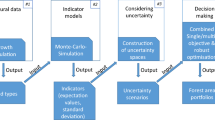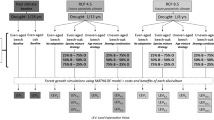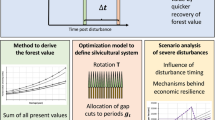Abstract
Context
In the context of climate change, several forest adaptation options have to be advocated such as a shift to more resistant species.
Aims
We provide an economic analysis of timber species change as a tool for adapting forests to climate change.
Methods
We use the framework of cost–benefit analysis, taking uncertainty into account both exogenously (sensitivity analysis) and endogenously [(quasi-)option value calculations]. We apply the method to assess the economic rationale for converting Norway spruce stands to Douglas-fir in the French Black Mountain.
Results
We find that the Douglas-fir conversion is land expectation value (LEV) maximizing under a wide range of a priori (subjective) probabilities attached to high mortality of Norway spruce under climate change (for probabilities higher than 0.25–0.31). If information about the impacts of climate change is expected to increase over time, and given the large sunk costs attached to conversion, a delay strategy may be preferable to transition and to status quo when the impacts of climate change on Norway spruce mortality are sufficiently ambiguous. In such cases, getting information earlier increases the LEV by €5–60/ha.
Conclusion
Beyond the specifics of the case study, this paper suggests that quasi-option value is a relevant tool to provide insights to forest owners dealing with adaptation decisions in the context of climate change.





Similar content being viewed by others
References
Abildtrup J, Strange N (1999) The option value of non-contaminated forest watersheds. Forest Policy Econ 1:115–125
Arrow KJ, Fisher AC (1974) Environmental preservation, uncertainty, and irreversibility. Q J Econ 88:312–319
Becker M, Nieminen TM, Geremia F (1994) Short-term variations and long-term changes in oak productivity in north-eastern France: the role of climate and atmospheric CO2. Ann For Sci 51:477–492
Bolte A, Czajkowski T, Kompa T (2007) The north-eastern distribution area of European beech: a review. Forestry 80:413–429
Bredahl Jacobsen J, Jellesmark Thorsen B (2003) A Danish example of optimal thinning strategies in mixed-species forest under changing growth conditions caused by climate change. Forest Ecol Manag 180:375–388
Bricenõ-Elizondo E, Garcia-Gonzalo J, Peltola H, Matala J, Kellomäki S (2006) Sensitivity of growth of Scots pine, Norway Spruce and Silver Birch to climate change and forest management in boreal conditions. Forest Ecol Manag 232:152–167
Carina E, Keskitalo H (2011) How can forest management adapt to climate change? Possibilities in different forestry systems. Forests 2:415–430
Conrad JM (1997) On the option value of old-growth forest. Ecol Econ 22:97–102
CRPF, ONF, Purpan (2007) Dépérissement des reboisements résineux de l’Aveyron et du Tarn. Etat des lieux. Miméo 5p
Deltombe M, Reboul JB, Toquard N, Bonaimé E (2008) Analyse économique de choix sylvicoles adaptés aux changements climatiques, rapport de TP d’économie, FIF-AgroParisTech, 38 p
Drèze J, Stern NH (1987) The theory of cost-benefit analysis. Chapter 14 in Handbook of Public Economics, vol 2., pp 909–989
Farjon A (1990) Pinaceae, drawings and description of the genera. Koeltz Scientific Books, Germany, 330 p
Guariguata MR, Cornelius JP, Locatelli B, Forner C, Sánchez-Azofeifa GA (2008) Mitigation needs adaptation: tropical forestry and climate change. Mitig Adapt Strat Global Change 13:793–808
Ha-Duong M (1998) Quasi option value and climate policy choices. Energ Econ 20:599–620
Hallegatte S, Lecocq F, de Perthuis C (2010) Économie de l’adaptation au changement climatique. Rapport du Conseil Economique pour le Développement Durable (CEDD)
Hanewinkel M, Hummel S, Cullmann DA (2010) Modelling and economic evaluation of forest biome shifts under climate change in Southwest Germany. Forest Ecol Manag 259:710–719
Hanewinkel M, Cullman DA, Schelhaas MJ, Nabuurs GJ, Zimmermann NE (2012) Climate change may cause severe loss in the economic value of European forest land. Nature Clim Change. doi:10.1038/nclimate1687
Harrison G, Rutström E (2008) Risk aversion in the laboratory. Res Exp Econ 12:41–196
Henry C (1974) Investment decisions under uncertainty: the irreversibility effect. Am Econ Rev 64:1006–1012
IPCC (2007) Climate change 2007, synthesis report. In: Pachauri RK, Reisinger A (eds) Contribution of working groups I, II and III to the fourth assessment report of the Intergovernmental Panel of Climate Change, Core Writing Team. IPCC, Geneva, Switzerland, 104 p
Kellomäki S, Peltola H, Nuutinen T, Korhonen KT, Strandman H (2007) Sensitivity of managed boreal forests in Finland to climate change, with implications for adaptive management. Philos Trans R Soc Series B Biol Sci 363:2341–2351
Klemperer WD (1996) Forest resource economics and finance, McGraw-Hill Series in Forest Resources. McGraw-Hill, New York, 551p
Lebègue D, Baumstark L, Hirztman P (2005) Révision du taux d’actualisation des investissements publics, Commissariat Général au Plan. France, 112 p
Lönnstedt L, Svensson J (2000) Non-industrial private forest owner's risk preferences. Scand J Forest Res 15:651–660
Mastrandrea MD, Field CB, Stocker TF, Edenhofer O, Ebi KL, Frame DJ, Held H, Kriegler E, Mach KJ, Matschoss PR, Plattner GK, Yohe GW, Zwiers FW (2010) Guidance note for lead authors of the IPCC Fifth Assessment Report on Consistent Treatment of Uncertainties. Intergovernmental Panel on Climate Change (IPCC). Available at: http://www.ipcc.ch
Nigh GD (2006) Impact of climate, moisture regime, and nutrient regime on the productivity of Douglas-fir in coastal British Columbia, Canada. Clim Chang 76:321–337
Nordhaus W, Popp D (1997) What is the value of scientific knowledge? An application to global warming using the PRICE model. Energy J 18:1–45
Peterson S (2006) Uncertainty and economic analysis of climate change: a survey of approaches and findings. Environ Model Assess 11:1–17
Peyron JL, Terreaux JP, Calvet P, Guo B (1998) Principaux critères économiques de gestion des forêts: analyse critique et comparative. Ann For Sci 55:523–551
Piermont L (2007) Changement climatique: l’inflexion de sylviculture engagée par la Société Forestière de la Caisse des Dépôts. Rev Forest Fr 59:129–135
Plantinga AJ (1998) The optimal timber rotation: an option value approach. Forest Sci 44:192–202
Seidl R, Rammer W, Lexer MJ (2011) Adaptation options to reduce climate change vulnerability of sustainable forest management in the Austrian Alps. Can J Forest Res 41:694–706
Seppälä R, Alexander B, Katila P (2009) Adaptation of forests and people to climate change. A Global Assessment Report. IUFRO World Series 22, Helsinki
Shou E, Bredhal Jacobsen J, Lokke Kristensen K (2012) An economic evaluation of strategies for transforming even-aged into near-natural forestry in a conifer-dominated forest in Denmark. Forest Policy Econ 20:89–98
Spiecker H (2000) Growth of Norway spruce (Picea abies [L.] Karst.) under changing environmental conditions in Europe. In: Klimo E, Hager H, Kulhavý J (eds) Spruce monocultures in Central Europe—problems and prospects. EFI Proceedings 33. European Forest Institute, pp 11–26
Spittlehouse DL, Stewart RB (2003) Adaptation to climate change in forest management. J Ecosystems Manag 4:1–11
Yousefpour R, Hanewinkel M, Le Moguedec G (2010) Evaluating the suitability of management strategies of pure Norway spruce forests in the Black Forest Area of Southwest Germany for adaptation to or mitigation of climate change. Environ Manage 45:387–402
Yousefpour R, Jacobsen JB, Thorsen BJ, Meilby H, Hanewinkel M, Oehler K (2012) A review of decision-making approaches to handle uncertainty and risk in adaptive forest management under climate change. Ann For Sci 69:1–15
Acknowledgments
The authors acknowledge the help of Eric Lacombe and four AgroParisTech students, Martin Deltombe, Jean-Baptiste Reboul, Nicolas Toquard and Emmanuel Bonaimé, for their contribution to the case study. We also thank Bo Jellesmark Thorsen and participants in the international conference “Tackling climate change: the contribution of forest scientific knowledge” held in Tours in May 2012 for helpful suggestions. Finally, we are grateful to two anonymous referees for their comments.
Author information
Authors and Affiliations
Corresponding author
Additional information
Handling Editor: Marc Hanewinkel
Contribution of the co-authors
Marielle Brunette: analysis in case of risk aversion, management of writing process and revision of the manuscript.
Sandrine Costa: case study development, analysis in case of risk neutrality and revision of the manuscript.
Franck Lecocq: implications for project analysis plus in-depth paper revision.
Rights and permissions
About this article
Cite this article
Brunette, M., Costa, S. & Lecocq, F. Economics of species change subject to risk of climate change and increasing information: a (quasi-)option value analysis. Annals of Forest Science 71, 279–290 (2014). https://doi.org/10.1007/s13595-013-0281-0
Received:
Accepted:
Published:
Issue Date:
DOI: https://doi.org/10.1007/s13595-013-0281-0




